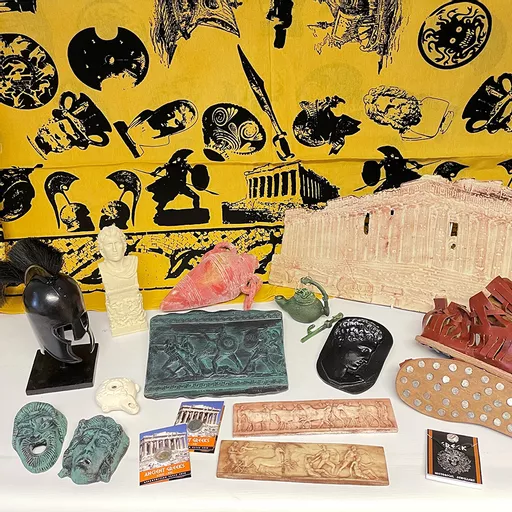How Greek Armour Was Made, Used, and How Effective It Was in Protection?
Introduction
Greek armour was a vital part of Ancient Greece's military prowess, particularly during the height of the city-states like Athens and Sparta. Designed not only to protect the wearer but also to signal rank and status, armour played a critical role in the success of Greek soldiers, especially the famed Hoplites. But how was this armour crafted, how was it used in battle, and just how good was it at protecting the warriors who wore it?
The Evolution of Greek Armour
Greek armour evolved significantly from the early periods through to the Classical era. Initially, early Greek warriors used simple protection, often just helmets and shields, with minimal body armour. By the time of the Classical period (5th-4th century BCE), armour became more elaborate, with distinct styles such as the Hoplite panoply becoming widespread.
Materials Used in Greek Armour
The primary material for Greek armour was bronze, a durable metal made by combining copper and tin. Bronze was prized for its ability to be molded into strong, protective shapes while remaining relatively lightweight. In addition to bronze, leather and linen were also used, particularly for more flexible or lighter armour. The linothorax, made of layers of stiffened linen, became popular in the later periods for providing decent protection while being less cumbersome than full bronze armour. In later periods, iron was also introduced for some armour parts, especially in helmets and weapons.
Types of Greek Armour
The Hoplite's Panoply
The term "panoply" refers to the full set of armour worn by a Hoplite, the standard citizen-soldier of Greek city-states. A typical Hoplite’s panoply included a helmet, a cuirass (breastplate), greaves (shin guards), and the famous round shield, known as the Aspis or Hoplon. The weight of this armour could range from 50 to 70 pounds, making it a balance between protection and mobility.
The Corinthian Helmet
One of the most iconic pieces of Greek armour was the Corinthian helmet, characterised by its full-face design, with a T-shaped opening for the eyes and mouth. This helmet provided extensive protection for the head but limited vision and hearing, making it both a blessing and a curse in battle.
Cuirass (Breastplate)
The cuirass was the breastplate designed to protect the torso. The bronze muscle cuirass, shaped to mimic the human torso’s muscular form, was a popular and impressive piece of body armour. However, the linothorax, made of layers of linen and sometimes reinforced with bronze scales, became a more flexible and lightweight alternative.
Greaves (Leg Guards)
Greaves were worn to protect the shins during combat. Made from bronze, they were shaped to fit snugly over the lower legs and were essential in protecting against low strikes.
Shield (Aspis or Hoplon)
Perhaps the most important part of a Greek soldier's armour was the shield, or Aspis, which was made of wood and covered with bronze. Measuring about 3 feet in diameter, the shield was crucial not only for personal defence but also for the protection of fellow soldiers in the phalanx formation.
How Greek Armour Was Made
Crafting Bronze Armour
Creating Greek bronze armour was a labor-intensive process. First, the metal was heated until molten, then poured into molds to form the rough shape of the desired piece. After cooling, armourers would hammer and refine the bronze, shaping it precisely to fit the wearer. Engraving and additional decorations were often added to signify rank or city-state.
Leather and Linen Armour Construction
The linothorax, in particular, involved stitching together layers of linen and soaking them in a glue-like substance to harden them. Leather armour, used for lighter protection, was tanned and treated to make it durable enough to withstand slashes and blows.
Helmets and Shields
Helmets like the Corinthian required skilled artisans to shape and fit the bronze to each warrior. Shields were often constructed by layering wood and covering it with bronze, sometimes with intricate designs that reflected the warrior’s allegiances or personal accomplishments.




Usage of Greek Armour in Battle
Hoplite Phalanx Formation
Greek armour was designed with a specific style of warfare in mind—the phalanx formation. In this tight formation, each Hoplite's shield protected not just himself but also part of the soldier next to him. This method allowed Greek armies to form an almost impenetrable wall, with each soldier’s armour playing a crucial role in the collective defence.
Manoeuvrability and Weight
While Greek armour was certainly heavy, it was balanced to allow a degree of manoeuvrability. The Hoplites needed to be mobile enough to march long distances yet remain protected during close combat. The cuirass and helmet provided excellent protection, but the heaviness could tire soldiers during prolonged engagements.
Effectiveness of Greek Armour
Protection Against Projectiles
Greek armour was generally effective at deflecting projectiles like arrows and javelins. The bronze breastplates and helmets were particularly resistant to these long-range attacks, although lighter linen and leather armour might be more vulnerable to penetration.
Close-Combat Protection
In hand-to-hand combat, Greek armour excelled. The sturdy cuirass could absorb the impact of slashing swords or thrusting spears, while the helmet protected against blows to the head. The shield was especially useful in close combat, allowing soldiers to block incoming attacks and strike from behind their defence.
Weaknesses of Greek Armour
Despite its strengths, Greek armour had some weaknesses. The legs and arms were often left relatively unprotected, and the weight of the armour could reduce a soldier’s endurance in battle. Additionally, while the Corinthian helmet provided significant protection, its limited vision and ventilation made it less practical in extended engagements.
Innovations and Adaptations Over Time
As warfare evolved, so did Greek armour. The transition from the bronze cuirass to the more flexible linothorax showed a shift towards lighter, more mobile armour. Greek armourers were also influenced by other cultures, particularly as Greek armies encountered new enemies, such as the Persians and later the Romans. These interactions led to innovations in armour design, with a focus on better mobility and comfort for the soldiers without sacrificing too much protection.
Comparison with Other Ancient Armours
Compared to the armour of other ancient civilisations, Greek armour was a middle ground between the heavily-armoured Roman legionnaires and the lighter, more mobile Persian infantry. Roman soldiers, especially in later periods, wore segmented armour (lorica segmentata), which allowed for better movement and flexibility while still providing significant protection. Persian warriors, on the other hand, often wore lighter armour made of leather or cloth, designed to maximise speed and agility. Greek Hoplite armour was heavier but provided superior protection in close-quarter combat, making it particularly effective in their distinctive phalanx formation.
Symbolism and Decoration in Greek Armour
Greek armour wasn’t just functional—it also carried significant symbolic meaning. The most prominent soldiers, often the wealthiest citizens, could afford highly decorated armour, with intricate designs engraved into their breastplates or painted onto their shields. These decorations could display symbols of the soldier’s city-state, family, or even personal achievements. The Aspis shield, for example, was often emblazoned with images of gods, mythical creatures, or powerful symbols such as the Gorgon, meant to intimidate enemies.
The decorative aspect of armour was not just about aesthetics; it was also about status. High-ranking officers and well-off Hoplites would showcase their wealth and rank through ornate armour, while regular soldiers had more utilitarian designs. In many ways, the artistry of the armour reflected the Greek value of arete, the pursuit of excellence in all things, including warfare.
How Greek Armour Influenced Later Cultures
Greek armour had a lasting impact on future civilisations. The Romans, who adopted and adapted much from the Greeks, incorporated elements of Greek armour design into their own military equipment. For example, the use of bronze and the style of the Greek helmet influenced early Roman designs. Additionally, the Greek emphasis on the importance of a shield as a primary defensive tool carried through into Roman military strategy.
Beyond Rome, Greek armour also influenced the Byzantine Empire, which carried on the traditions of the Roman Empire. Even after the fall of classical Greece, the legacy of their armour continued to echo through the ages in different forms.
The Decline of Heavy Armour
Over time, the use of heavy bronze armour began to decline. This was partly due to advancements in weaponry. As new offensive technologies emerged, such as more powerful bows and later siege weapons, heavy armour became less effective and more cumbersome. Additionally, the changing nature of warfare, which began to emphasise mobility and ranged combat, made lighter armour more practical for soldiers on the move.
By the Hellenistic period, many Greek soldiers wore lighter armour, and some even fought without breastplates, relying more on shields and tactical formations for protection. The decline of the Hoplite style of warfare and the rise of more professional, full-time armies also contributed to this shift.
Conclusion
Greek armour was a marvel of ancient craftsmanship, balancing protection with mobility and displaying the culture’s appreciation for both functionality and artistry. From the early bronze cuirasses to the more flexible linothorax, Greek armour played a critical role in the success of the famous Hoplites in battle. It was especially effective when used in the phalanx formation, where shields and armour combined to create an almost impenetrable wall of soldiers.
Though it had its weaknesses, such as leaving some parts of the body exposed and being heavy for long engagements, Greek armour was highly effective in the context of ancient warfare. It protected soldiers from both projectiles and close-combat strikes, and its influence continued to resonate through subsequent cultures, from the Romans to the Byzantines.
In the end, Greek armour wasn’t just about protection—it was a symbol of the warrior’s status, a testament to the Greek commitment to excellence in all things, and a key component of one of history’s most formidable fighting forces.
FAQs
1. Why was bronze commonly used in Greek armour?
Bronze was one of the most readily available metals during ancient Greek times, and it had excellent properties for armour-making. It was strong, durable, and could be easily molded and shaped, making it ideal for creating protective gear such as helmets and breastplates.
2. How heavy was a full set of Hoplite armour?
A full set of Hoplite armour, including the helmet, cuirass, greaves, and shield, typically weighed between 50 and 70 pounds (22-32 kg). The bulk of the weight came from the bronze components, particularly the breastplate and shield.
3. Did all soldiers in Ancient Greece wear the same armour?
No, armour varied depending on a soldier’s wealth, rank, and role in the army. Wealthier soldiers, who could afford better equipment, wore more elaborate and protective armour, while poorer soldiers or lightly armed troops, like peltasts, wore lighter gear, often just carrying a shield and spear.
4. How long did it take to make a set of armour?
Making a set of bronze armour could take weeks or even months, depending on the complexity and detail. Armourers needed time to mold, hammer, and fit the metal, especially for custom pieces tailored to a specific soldier. The more elaborate the design, the longer it would take.
5. What was the most vulnerable part of a Greek soldier?
Despite their heavy armour, Greek soldiers were still vulnerable in several areas, particularly the thighs, upper arms, and neck. While shields provided additional protection, these parts were often left exposed due to the limitations in armour coverage and the need for mobility.














